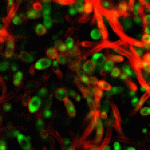Lien vers Pubmed [PMID] – 26242223
Cell. Microbiol. 2015 Aug;
Candida albicans is the most frequent yeast responsible for systemic infections in humans. These infections mainly originate from the gastro-intestinal tract where C. albicans can invade the gut epithelial barrier to gain access to the bloodstream. Along the gut, pathogens can use Microfold (M) cells as a portal of entry to cross the epithelial barrier. M cells are specialized cells mainly located in the Follicule Associated Epithelium (FAE) of Peyer Patches. In this study, we used scanning electron and fluorescence microscopy, adhesion and invasion assays and fungal mutants to investigate the interactions of C. albicans with M cells obtained in an established in vitro model whereby enterocyte-like Caco-2 cells co-cultured with the Raji B cell line undergo a phenotypic switch to morphologically- and functionally-resembling M cells. Our data demonstrate that C. albicans co-localizes with and invades preferentially M cells, providing evidence that the fungus can use M cells as a portal of entry into the intestinal barrier. In addition to active penetration, F-actin dependent endocytosis contributes to internalization of the fungus into M cells through a mechanism involving hypha-associated invasins including Ssa1 and Als3.


